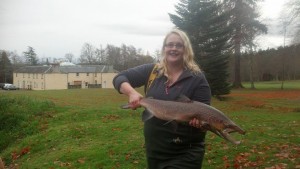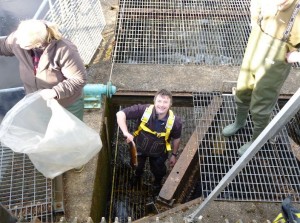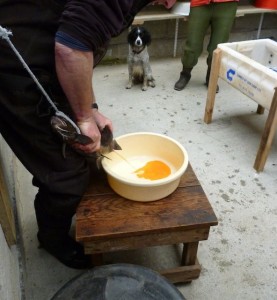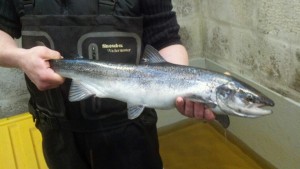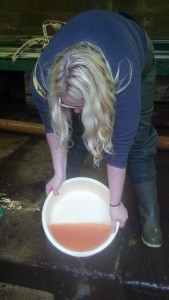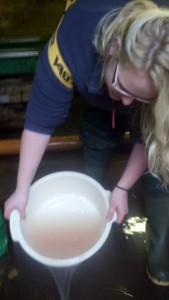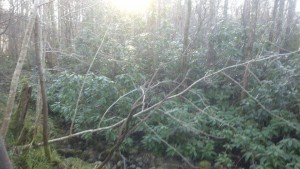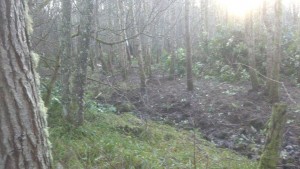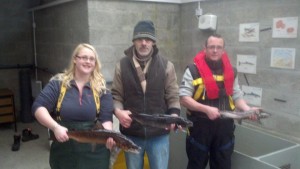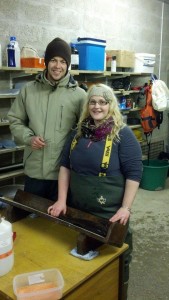
I have been working with Cromarty Firth Fisheries Board for 2 months now and am getting a good idea of what the staff Cromarty Firth do on a day to day basis, and have learnt lots of valuable skills in fisheries management.
I started at Cromarty Firth in November, an exciting time of year for fisheries managers, as the salmon are beginning to spawn. The fisheries board runs a trapping operation on a loch on the River Blackwater. I spent most of my first month at Cromarty wearing chest waders in the fish trap, a big metal cage suspended above a Loch.
One of the first skills I learnt was salmon wrestling, when picking out the salmon from the trap. The trick is to pick up a salmon by the tail using your thumb and forefinger to grip. The salmon are not so keen on being handled, and try really hard to get away, so salmon wrestling was a key skill I picked up in November. Unfortunately for me the salmon are passed up to colleagues on a platform at around head height, and particularly vigorous salmon occasionally managed to slap me in the face.
The salmon that had been trapped were taken into the holding tanks at the loch and we separated the cock fish from hen fish. The hen fish are then separated between fish that are ‘ripe’ – ready to spawn and ‘hard’ not quite ready. Throughout November and December we took cock fish and ripe hens and stripped the fish of eggs and milt to provide up with fertilised eggs to stock our hatchery.
Stripping fish is another skill I have learned and the different techniques used between cock and hen fish. The fish are dried thoroughly before being placed in a noose/ rope harness to support the bodyweight, and stripped into bowls. After the eggs are fertilised they are washed. The washing process is important to prevent fungus and bacterial growth. The eggs then are left to harden and are taken to the hatchery where they are checked daily. Over 1300 salmon were trapped and stripped this year, and we are currently looking after 1.9 million eggs in the hatchery, that will be planted out in rivers and burns in soon.
By January the fish have all spawned and mostly died. This is an important stage in the salmon life cycle to return nutrients to the ecosystem. This gives the staff at the fisheries board time to get on with some good old fashioned conservation. We have spent January on the banks of the River Orrin getting to grips with rhododendron clearance. We are using a lever and mulch technique to clear the banks allowing regeneration by native species.
This is a slightly more relaxed time which is important as it is giving me the time to study for my upcoming Institute of Fishery Management Water Bailiff exams. Hopefully I will pass these in March and obtain a warrant card to be a fully fledged water bailiff, and therefore the fish police!
Back in November I was involved in an incident on the River Peffery, in which an individual was caught breaking the law, by fishing out of season. It was very exciting, and I learnt some import bailiff skills such as observation, proper notebook keeping and got to be involved with an actual arrest. In the summer I will be bailiffing most days so it’s important to know the legislation really well, and my mentor, Edward Rush, the head bailiff is testing my knowledge of fisheries legislation to help me prepare.
It has been a real whirlwind of a start to working with the fisheries board, I am learning so many practical skills! Hopefully I will be able to keep up this fantastic learning curve and step up my game to gettong involved with a braoder spectrum of management skills. You only get one apprenticeship and there is only one Natural Talent and I am determined to make the most of it. More posts to follow soon.
Natalie – Fisheries Management Appretice

